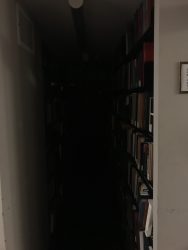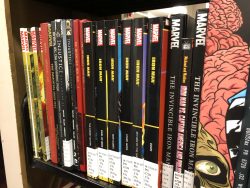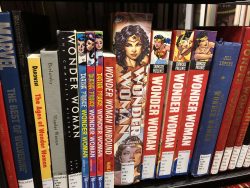Bwogger Chloe Gong ventured into Butler stacks to investigate its mysterious collections. You won’t believe what she saw.
For every Columbia student, writing a Progression 3 research paper in UW is a rite of passage—one that even Timothée Chalamet couldn’t escape. But if you’re lucky like me, you might get an instructor who lets you write a paper on your favorite Marvel character. To begin my research, I followed my teacher’s advice and started looking for sources I could use on CLIO, the online catalog containing all of Barnumbia’s library resources. Lo and behold, an entire collection of Iron Man comics showed up in my search results—and apparently, they were all located on the tenth floor of Butler Stacks. Of course I had to go check it out.
When I got off the elevator, I followed the call number to the correct aisle. Staring into the dark abyss between two shelves, I wondered what was on the other side. After summoning up my courage, I turned on the light. I was not prepared for what I saw…

Not only were the Iron Man comics perfectly stacked upon the shelf awaiting my arrival, but the entire aisle was filled front to back and top to bottom with all kinds of graphic novels, including a wide variety of comics from Marvel, DC, and even Japanese manga.
Now, I’m not sure if I’m just oblivious, but I was genuinely surprised to find this little island of books with captivating, colorful covers coexisting among the many serious and edgy works of academia on the same floor. I started to wonder: when was the last time someone had actually visited this section of the stacks? How did it even get here?
After doing a little research online, I decided to direct my curiosities toward Karen Green, who has been the curator for Columbia University Libraries’ Comics and Cartoons since 2005.
First, I wanted to know how this impressive collection came to be. Green told me that in 2005 when she had the thought of starting the collection, there wasn’t any evident demand for comics, but she proceeded with the mindset of “if I build it, they will come.” She pitched her idea to a group of people connected with collection development, arguing that comics/graphic novels as a medium has risen in its relevance to academia, and would also benefit Columbia’s film studies program. She secured a small budget and began turning her ideas into reality.
The collection started off focusing mostly on industry award-winners: the Eisner Awards presented at Comic-Con in San Diego, the Harveys that were originally presented at Baltimore Comic Con, and the Ignatzes for independent comics at the Small Press Expo. As her budget grew, she expanded the scope to works with literary, artistic, social, or pedagogical merit. “The collection which began with three graphic novels in 2005, now numbers roughly 15,000 titles in over two dozen languages,” Green says.
Aside from the collection’s origin, I was also interested in how it was organized and why it happened to be sandwiched between rows with books of completely different genres and time periods. Green told me, while all books acquired in the past 50 or 60 years are classified according to the Library of Congress Call-Number Classification System, rules regarding comics don’t always follow a discernible logic. A vast majority of the graphic novels collection has been shelved on floor ten, under the umbrella heading of Literature, with a subheading of Comic books, strips, etc., but a large number also exist on floor nine, under the main heading of Art. In addition, certain books are shelved according to their topic—for example, Maus is in the World War II history section.
“As a result of this physical dispersion, and the absence of a consistent clickable subject heading in CLIO, we made the decision to unite the entire collection in the three fourth-floor reading rooms where the Barnard Library books were shelved during the new library’s construction,” Green added. “That move is currently underway and will allow the entire collection to be browsed with ease.
In addition to its graphic novel collection, Butler’s sixth floor also houses the Rare Book & Manuscript Library, which has really interesting artist books and comics archives that are worth checking out. The Barnard Zine Library, curated by Jenna Freedman, is also a great place to explore non-traditional forms of literature. According to Green, Freedman is someone who’s been a big inspiration to her, and the two often compare notes. “I think zines and comics are important mediums for expression,” says Green. “Comics reflect our increasingly visual culture and have a distinct language that’s worth learning. It’s a complex medium that can explore anything from the peculiarities of daily life to the nightmare of the refugee experience.”
However, Green isn’t the only one who has acknowledged comics’ importance in education. Several courses at Columbia have incorporated the study of graphic novels into their curriculum: every few years, Professor Jeremy Dauber teaches an American Studies class called “The American Graphic Novel”; the MS program in Narrative Medicine up at the medical school takes advantage of illness narratives—the genre known as “graphic medicine.” As time goes on, it is likely that more and more classes will begin this kind of integration.
Lastly, I asked Green if she thinks students generally know how to navigate all the amazing and diverse resources Columbia’s libraries have to offer, and what we might do to improve awareness. She responded that in her experience, although most students know how to find what they need for courses and research, they tend not to know about much else. Materials in the Rare Books library often seem intimidating, but students whose professors bring their classes in to look at their holdings often come back later to see more. To my surprise, Green also mentioned that about a decade ago, a Bwogger started a series highlighting lesser-known areas of the Libraries, but then she graduated. Folks, is it time to bring this back?
After leaving the stacks that day, I couldn’t help but think: if I hadn’t stumbled upon the tenth-floor comics collection that day looking for a very specific Iron Man comic, would I have gone four years never knowing of its existence? But now that I’ve also told YOU about it, why not go see it for yourself?
Image via Bwogger Chloe


 1 Comments
1 Comments



1 Comment
@Karen Green Thank you, Chloe! I look forward to hearing your response to the new 4th-floor rooms…